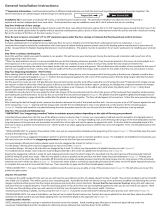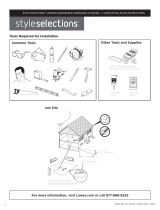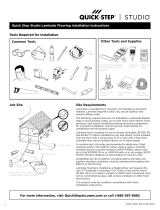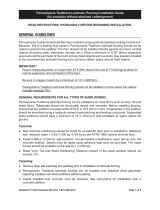Page is loading ...

Mohawk® Laminate Installation Instructions
GENERAL
Uniclic® is a revolutionary system for installing laminate floors without using glue.
The planks can be clicked together simply, thanks to the ingenious shape of the
tongue and groove. Uniclic® is unique because you can install the planks in two
different ways:
Method A: Angle-In installation method
Position the plank to be installed at an angle of 20 to 30° to the plank already
installed. Move the plank gently up and down and at the same time exert forward
pressure. The planks will automatically click into place. You can either insert the
tongue into the groove, or the groove into the tongue. The tongue in groove
method is the most common and the easiest way. See diagram 1A-1B-1C.
Method B: Flat installation method
(Flat installation method): With Uniclic® you can also tap the planks into each
other without lifting. For this method you must use the special Uniclic® tapping
block. The planks should not be joined with a single tap and the tapping block
should be sitting flat on the floor. To avoid damaging the planks you must tap
them together gradually. See diagram 2A-2B. Use this method only in cases
where you are unable to use the Angle-In method (see below). The rest of your
floor should be installed using the angle-In method.
TOOLS FOR INSTALLING THE FLOOR
For best results, it is essential that you follow the installation instructions exactly.
Besides the regular tools for installing laminate floors (i.e. hammer, saw, pencil,
measure) you will also need the following accessories:
• Installation kit (pull bar, spacers (1-8 mm / 0.039”-0.315”) and Uniclic®-adapted
tapping block)
• Maintenance products
• Underlayment system
You may also need to saw the planks. To obtain a clean cut, the pattern side
should face down when you use a jigsaw, sabre saw or circular handsaw and up
when you use a handsaw, table saw or a crosscut saw.
10 FOCUS POINTS
1. Thanks to the Uniclic® system, the floor floats and is installed without glue.
You can walk on the floor during and immediately after installation.
2. With Uniclic® planks you can choose where you want to begin. Think about
what will be the easiest way to install the floor. We will demonstrate the
installation for right-handed people, from left to right. You can work in the other
direction if you want.
3. Make sure the planks are mixed sufficiently when you install them, so that you
do not end up with too many identical, light or dark planks next to each other.

4. Check all planks in daylight before and during installation. Defective planks
must never be used.
5. The floor should preferably be installed parallel to how the light enters the
room. The ideal conditions are 15-20°C (59-68°F) at a relative humidity of 50-
60%.
6. Under normal conditions*, Mohawk® flooring requires no acclimation period.
Outside of the normal conditions, let the planks acclimate for 48 hours in the
unopened packaging at the normal room temperature in the middle of the room
where the floor is to be installed. *Normal conditions means a difference of no
more than 25°F and 20% relative humidity between the stocking/transportation
environment of the flooring and the final installation environment of the flooring.
7. Room humidity can vary according to the season, so it is vital that the floor is
able to expand and contract. For this reason, make sure you leave an expansion
joint of minimum 8 to 10 mm (5/16” to 3/8”) on all sides of the floor, around pipes,
thresholds, under doors and around any fixed/stationary objects (floor vents,
kitchen islands, etc..).
8. Large rooms must have expansion joints every 13 m (40 feet) width-wise to
the planks and every 13 m (40 feet) length-wise. It is recommended to provide an
expansion joint between different rooms (e.g. under the door). Expansion joints
can be finished by means of a molding that is attached to the subfloor.
9. Ensure that the end joints of the planks in two successive rows are never in
line. Always ensure that the joints are staggered by at least 15 cm / 6 inches.
10. We recommend you purchase a few extra cartons of flooring. This will be
useful to you if you have some damaged pieces, miscalculate the size of the
room, or miss cut some pieces. This also will help you if your floor needs a repair
but your product is no longer manufactured.
PREPARING THE ROOM
• If 7mm product, allow the laminate flooring to acclimate for 48 hours in its
sealed packaging in the middle of the room where it is to be installed. Mix planks
from different cartons when installing to maximize the natural look of the floor.
• Check that the doors can still open and close after the floor has been installed
(minimum + 1 cm (3/8”))
• Check whether the old molding can be removed. You can also leave the wall
base and finish the floor with Mohawk® profiles.
• Make sure the subfloor is flat. Any unevenness greater than 2 mm (1/16”) over
the length of 1 meter (40”) must be smoothed out. It is vital that you use
underlayment to smooth any unevenness in the base floor. The specially
designed Mohawk® underlayment has a damp proof, insulating, noise reducing,
and leveling function.
• Make sure the subfloor is clean, dry and stable.
• Flooring may be installed over radiant heat systems following special
installation instructions. Contact your retailer or visit our website
www.mohawkflooring.com for further details.

CONCRETE SUBFLOOR:
New Construction:
• A new concrete floor must dry at least 1 week per 1 cm (3/8”) thickness up to 4
cm (1-1/2”). Thicknesses over 4 cm (1-1/2”) require twice as much drying time.
For example, a 6 cm (2-1/2”) concrete subfloor must dry for at least 8 weeks. The
moisture content must be less than 2.5% (CM method) or less than 5 lbs/24 hour
per 1000sqft (Calcium chloride method ASTM 1869).
Renovation:
• Remove any damp-porous floor covering (carpet, needle felt, etc.) first.
• Damp-sealed floor covering (PVC, linoleum, VCT, etc.) does not have to be
removed. Always use underlayment and damp-proof membrane.
WOODEN SUBFLOOR
• Remove any existing damp-porous floor covering first.
• Make sure the sub floor is stable. Nail down any loose parts and apply a
leveling layer if necessary.
• Install the Uniclic® planks crosswise to the direction of the existing subfloor.
• It is necessary that the crawl space under the plank floor is sufficiently
ventilated. Remove any obstacles and provide sufficient ventilation (minimum 4
cm (1-1/2”) of total ventilation holes per meter (40”) of floor). The moisture
content of the wood may not exceed 12%.
INSTALLING THE FLOOR
• First install the underlayment, per width and gradually as you progress. If the
underlayment is pre-mounted on the planks, then only use a damp-proof
moisture barrier with water resistant adhesive tape. For Concrete, let the
membrane run up the wall a bit before cutting to size. For wood, cut the moisture
barrier 1 inch from the wall. A molding will be attached to this later. See diagram
3A.
• Begin the first row with a whole plank. First, saw off the tongue on both the long
and the short sides. See diagram 3B.
• Put the plank with sawn off sides against the walls. Put spacers from the
installation kit between the planks and the wall. This will ensure that your
expansion joint is wide enough: 8 to 10 mm (5/16” to 3/8”). See diagram 3C.
• The diagrams indicate where the Uniclic® planks are clicked together by
angling up and down or where they are tapped together flat. Follow the diagrams
precisely. See diagrams 4.1- 4.16
• In places where it is too difficult to install the Uniclic® planks with the tapping
block (e.g. against the wall), you can tap them together using the pull bar and a
hammer. See diagrams 5A-5B-5C.
• There must also be an 8 to 10 mm (5/16” to 3/8”) expansion joint between the
last row and the wall. Keep this in mind when sawing the last row of planks.

INSTALLATION IN WET AREAS
Since prolonged water exposure could damage your laminate flooring, the
following installation recommendations should be closely followed to validate
your residential water warranty. Wet areas would include, but not limited to,
bathrooms, powder rooms, kitchens, mud rooms, foyers, and laundry rooms.
Neither Mohawk® flooring planks nor Mohawk® accessories are recommended
for extreme humid applications such as in saunas or swimming pool areas. The
water warranty excludes all products thinner than 8mm and does not apply to
beveled edge products when used in bathrooms. An expansion area of 8 to
10mm (5/16” - 3/8) must be provided around all vertical obstructions including
walls, permanent cabinets, pipes, etc. All perimeter expansion areas must be
completely filled in with a water repellent flexible silicone sealant. When applying
sealant, it is helpful to first apply a strip of masking tape parallel to and
approximately 1mm (1/32”) from the edge of the flooring. Then fill the expansion
area with sealant, remove any excess with a plastic scraper or putty knife, then
remove the tape. Let dry for 24 hours before exposure to water.
PIPES
In rows where there is a pipe, make sure the pipe falls exactly in line with the
short side of two planks. Take a drill bit with the same diameter as the pipe plus
20 mm (3/4”) for the expansion. Click the planks together on the short side and
drill a hole centered on the joint between the two planks. Now you can install the
planks in the floor. See diagrams 6A-6B-6C.
UNDER DOORFRAMES
When sawing the planks, ensure that the expansion joint under the door is at
least 10 mm (3/8”). If you cannot lift the plank, use an adapted tapping block or
pull bar and hammer to tap the planks together with the planks flat on the floor.
See diagrams 7A-7B.
FINISHING
• Remove all spacers.
• Install the molding on the plastic membrane that runs up the wall from under the
floor. Never attach the molding to the floor. This method allows the floor to
expand and contract under the molding. (See diagram 8A.)
• For a perfect finish around pipes, use rosettes or flexible silicone caulking.
• In places where profiles or skirting cannot be placed, fill expansion gaps with
flexible silicone caulking.
PRECAUTIONS
• Protect furniture and chair legs with proper felt or rubber caps.
• Avoid bringing dirt, water and sand indoors by providing a suitable solid backed
floor mat at the door.
• Furniture on casters/wheels must use soft, rubber wheels that are suitable for a
laminate floor and/or use a suitable protective mat.

• Ensure that humidity in the room is always at least 50%. Use a humidifier if you
need to.
MAINTENANCE
• The smooth surface of your laminate means it is virtually maintenance free.
• Never use wax, polish, oils, soaps, detergents, shine enhancers, or varnish on
the floor.
• For dry maintenance, we recommend a dust mop or vacuum cleaner with soft
bristle brush only.
• For slightly damp maintenance, we recommend a laminate cleaner which you
spray directly and lightly on a duster. Always wipe dry immediately until no more
moisture is visible on the floor. The use of other cleaning products might damage
your floor. For bevel edge products, we strongly recommend dry cleaning only.
• Do not use any type of cleaning machine such as spray mops, steam cleaners/
mops or power cleaners.
• Wet maintenance is absolutely forbidden. Remove any water immediately.
Uniclic® planks are not suitable for use in damp spaces like saunas.
• Remove stubborn stains carefully with acetone based fingernail polish remover.
Never use scouring products!
• In case your floor needs repair, a tool is available called Unifix which allows the
damaged floor plank to be easily removed in minutes without replacing the entire
floor. For Unifix to work properly the required expansion gap must be in place
around the room’s perimeter and extra flooring should be available for use in the
repair. Enjoy your floor.
ATTN: INSTALLERS Caution: Wood Dust
Sawing, sanding and machining wood products can produce wood dust. Airborne
wood dust can cause respiratory, skin and eye irritation. The International
Agency for Research on Cancer (IARC) has classified wood dust as a nasal
carcinogen in humans.
PROPOSITION 65 WARNING: Produces wood dust when cut. Wood dust is
known to California to cause cancer.
Precautionary Measures: Power tools should be equipped with a dust collector.
If high dust levels are encountered use an appropriate NIOSH designated dust
mask. Avoid dust contact with skin and eyes. First Aid Measures in case of
irritations: In case of irritation flush eyes and skin with water for at least 15
minutes. For questions please contact Technical Services at: 1-888-387-9882,
option 1.
IMPORTANT HEALTH NOTICE FOR MINNESOTA RESIDENTS ONLY:
THESE BUILDING MATERIALS EMIT FORMALDEHYDE. EYE, NOSE, AND
THROAT IRRITATION, HEADACHE, NAUSEA AND A VARIETY OF
ASTHMALIKE SYMPTOMS, INCLUDING SHORTNESS OF BREATH, HAVE
BEEN REPORTED AS A RESULT OF FORMALDEHYDE EXPOSURE.
ELDERLY PERSONS AND YOUNG CHILDREN, AS WELL AS ANYONE WITH

A HISTORY OF ASTHMA, ALLERGIES, OR LUNG PROBLEMS, MAY BE AT
GREATER RISK. RESEARCH IS CONTINUING ON THE POSSIBLE LONG-
TERM EFFECTS OF EXPOSURE TO FORMALDEHYDE. REDUCED
VENTILATION MAY ALLOW FORMALDEHYDE AND OTHER CONTAMINANTS
TO ACCUMULATE IN THE INDOOR AIR. HIGH INDOOR TEMPERATURES
AND HUMIDITY RAISE FORMALDEHYDE LEVELS. WHEN A HOME IS TO BE
LOCATED IN AREAS SUBJECT TO EXTREME SUMMER EMPERATURES, AN
AIR-CONDITIONING SYSTEM CAN BE USED TO CONTROL INDOOR
TEMPERATURE LEVELS. OTHER MEANS OF CONTROLLED MECHANICAL
VENTILATION CAN BE USED TO REDUCE LEVELS OF FORMALDEHYDE
AND OTHER INDOOR AIR CONTAMINANTS. IF YOU HAVE ANY QUESTIONS
REGARDING THE HEALTH EFFECTS OF FORMALDEHYDE, CONSULT
YOUR DOCTOR OR CALL LOCAL HEALTH DEPARTMENT.
WARNING! DO NOT MECHANICALLY CHIP OR PULVERIZE EXISTING
RESILIENT FLOORING, BACKING, LINING FELT, ASPHALTIC “CUTBACK”
ADHESIVES OR OTHER ADHESIVES. PREVIOUSLY
INSTALLED RESILIENT FLOORING MAY CONTAIN EITHER ASBESTOS
FIBERS OR CRYSTALLINE SILICA. THE PRODUCTS IN THIS BOX DO NOT
CONTAIN ASBESTOS.
Avoid creating dust. Inhalation of such dust is a cancer and respiratory tract
hazard. Smoking by individuals exposed to asbestos fibers greatly increases the
risk of serious bodily harm. Unless positively certain that the product is a non-
asbestos containing material, you must presume it contains asbestos.
Regulations may require that the material be tested to determine asbestos
content and may govern the removal and disposal of material. See current
edition of the Resilient Floor Covering Institute (RFCI) publication
“Recommended Work Practices for Removal of Resilient Floor Coverings” for
detailed information and instructions on removing all resilient covering structures.
For service under this warranty please contact your local Mohawk® retailer or
mail in proof of purchase and description of claim to:
Mohawk Industries
Attention: Warranty Claims Department
508 East Morris Street
Dalton, GA 30721
877-ASK MOHAWK
www.mohawkflooring.com
Mohawk® Flooring is manufactured and distributed by:
Unilin Flooring NC, LLC • 550 Cloniger Drive
Thomasville, NC 27360

/




